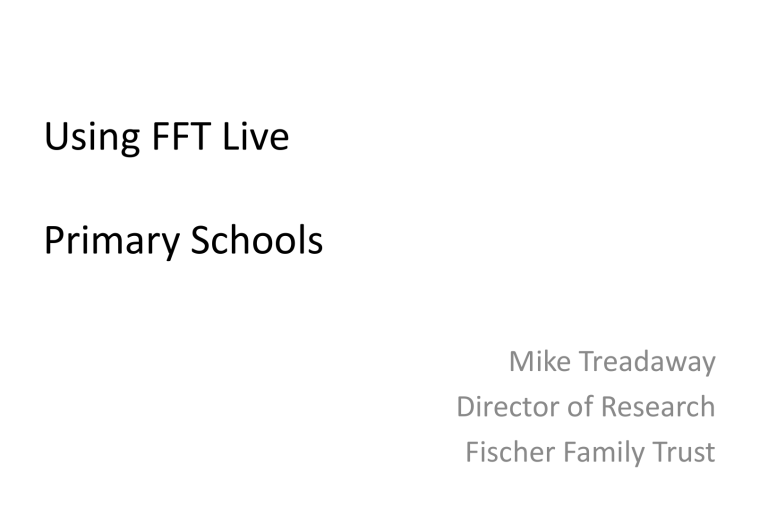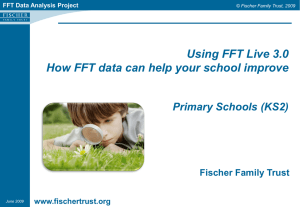School Subject Estimates

Using FFT Live
Primary Schools
Mike Treadaway
Director of Research
Fischer Family Trust
Contents
Data Landscape
• Change and Continuity?
FFT Live
• Self-Evaluation
• Estimates - Particularly KS1
• Data Literacy – Applying Key Principles
Other Reports
• Student Explorer
• Exports
FFT
DfE
Value-Added
Contextual
Value-Added
3 Year
Summaries
Estimates
Data Landscape
2002 2003 2004 2005 2006 2007 2008 2009 2010 2011 2012
Also:
• Floor Standards
• Expected Progress
Whether or not to Contextualise?
Type of Analysis Advantages Disadvantages
Raw Outcomes e.g. %L4+ Provides a view as to whether pupils are attaining the knowledge and skills needed for their next stage of education?
When used to compare schools, depends strongly upon attainment of the school’s intake.
Value-Added
Contextual Value-Added
Enables a focus upon progress irrespective of context e.g.
How well are our FSM pupils doing compared to our non-
FSM pupils?
Comparing value-added outcomes for schools with different contexts and makeup of intakes can be misleading.
Aims to take account of factors which are outside the school’s control and which, from analysing national data, can be shown to influence progress.
If used to look ahead
(estimates) then danger of
‘self-fulfilling prophecy’ for pupils in groups who currently under-perform nationally.
Differences – VA and CVA
• Compare PA (Value-added) and SX (Contextual Value-Added) outcomes for KS2->4 in 2009/10.
– Use KS2 Average Points Score as outcome measure.
– Look at how many change significant state.
– Analyses by grouping schools in different socio-economic contexts.
School
Context
Q1
Q2
Q3
Q4
VA compared to CVA
Better Worse
14%
9%
4%
8%
7%
11%
11%
9%
School Change in VA Score
Context Avg Min Max
Q1
Q2
Q3
Q4
+0.30
+0.01
-0.08
+0.05
-1.6
-1.6
-1.6
-1.8
+1.6
+3.0
+1.9
+2.2
To get some idea of the likely change for your school, compare PA and SX value-added outcomes on FFT Live or in FFT Self-Evaluation reports.
In Lambeth, most schools have VA better than CVA – this is mainly related to the progress of ethnic minority pupils.
Recommendations
For Self-Evaluation:
• VA (FFT PA model) and CVA (FFT SX model) are both important
• Contextual Value-Added is probably still the best starting point
• For schools with high % of ethnic minority pupils (other than Black Caribbean) CVA is likely to be LOWER than VA
• If CVA is good, particularly in a school serving a socio-economically disadvantaged area,
VA provide a view as to whether pupils are making good progress irrespective of context
For Estimates:
• Thinking about range is probably the most important principle
• PA model probably the best starting point, but need to take account of:
• What the school has achieved in previous years
• Impact of pupil characteristics and school context
• Other factors, including parental support, school interventions .....
And, in the end, what matters most to each pupil is the knowledge and skills they take with them to the next stage of their education!
Expected Progress
• DfE Approach
– Whole Levels, Subject Specific Input
– So, for example, 84% L2 in Mathematics at KS1 attained L4+ at KS2 in
2011
• FFT Approach
– Differentiate within levels where possible (2ABC)
– Take into account prior attainment in English and Mathematics
KS1 Maths
2C
2B
2A
KS2 L4+ Maths
58%
86%
97%
KS1 English
1
2C
2B
2A
3
L4+ KS2 Maths
80%
82%
86%
89%
92%
FFT Live
Includes:
• Latest updates
• Future releases
• Help Files
SETS
• Key Changes for 2011
– Default changed to PA (Prior Attainment)
– SX (Contextual VA) continues to be available
– Option to SORT available on Pupil Estimates report
Self-Evaluation
Significant Areas Grid
• Range of pupil groups and indicators
• KS1 Contextual and KS1->2 VA / CVA
• 3 Year summary, Overall + Trends
Significant Areas Detail
• Shows actual attainment and VA/CVA scores for each year
• Can be accessed by clicking on Significant Areas grid
Pupil Value-Added
• KS1->KS2, VA or CVA
• Highlights where progress is mode than half a
NC level above or below national average
Estimates
School Summary Estimates
• Range of Indicators and Pupil Groups
• A – PA 50 th Percentile; B – SE 50 th Percentile,
• D – SE 25 th Percentile; S – School Previous
Pupil Summary Estimates
• Types A, B, D
• Range of indicators (overall level, L4+, L5+)
• Reading and Writing not included
School Subject Estimates
• Core Subjects including Reading and Writing and Expected
Progress for English and Mathematics
• Outcomes for all levels (not just L4+ and L5+)
• Some pupil groupings available
Pupil Subject Estimates
• Can be accessed directly or from School Subject Estimates
• Show likelihood of attaining all levels (L2 to L5)
• Also provides option to show ‘most likely level’
Using Estimates
Two basic approaches
• Start with pupil data
• Take into account other factors
• Add up and compare with overall estimates
• Revise as necessary to arrive at overall targets
• Use overall estimates and evaluation of past performance to draft overall targets
• Use ‘RANK’ option in FFT School
Subject Estimates to set overall figure at your overall targets
• Click on link to pupil estimates
• Estimate -> Prediction -> Target
• Consider option of range - realistic and ambitious
• Don’t add up ‘estimated levels’
Adding up estimated levels – why not?
• Consider a group of 20 ‘identical’ pupils
• They all have the same estimates:
L2
5%
L3
20%
L4
50%
L5+
25%
GM
4
HGM
25%
GA
5
If we add up the ‘GM’ grades
L2
0
L3
0
L4
20
L5
0
If we average the ‘chances’ for each level and multiply by number of pupils
L2
5%
1
L3
20%
4
L4
50%
10
L5
25%
5
Note : Adding up predicted or target grades is fine – assuming that they are not simply just using unmoderated estimates!
KS1 Estimates
• In development section
• Introduced in summer 2011 following a year of trialling and feedback – which was very positive!
• Examples of relationship between FSP and KS1 attainment
CLL -> Reading
MAT -> Maths
Remember that these are averages!
40%
35%
30%
25%
20%
15%
10%
5%
0%
Chart below shows KS1 Maths
Levels for FSP MAT scores between 18 and 22
EYFSP MAT score between 18 and 22
1 2C 2B
KS1 Mathematics Level
2A 3
Factor
Overall EYFSP Score
CLL Score
MAT Score
PSE Score
Gender
Age
Socio-Economic Context
FSP to KS1 - Factors
PA Model
Approximate
Weightings
SE Model
CLL
MAT
PSE
Gender
Age
KS1 Reading
58%
26%
8%
5%
2%
KS1 Writing
58%
24%
5%
11%
1%
KS1 Mathematics
44%
43%
3%
9%
1%
Other Reports
• Export Section
• Provides additional data (e.g. UPN,
FFT_ID) which is not available on
SETS reports
• Removes formatting and colours, so easier to import into other systems
• Student Explorer
• Select students by range of characteristics
• Look at individual pupil history
• Developments:
• FSM as pre-set group (can currently select using drop-down menus)
• Pilot estimate report which takes into account factors such as EAL and when arrived in UK
Questions
We have introduced KS1 estimates
• Should we also include KS1 Value-Added reports
• School-Level?
• Pupil-Level?
Student Explorer
• Ability to select by FSM (current or ever) will soon be included
• Are there any other important pupil characteristics which would be useful to have easily available on the main menu?






